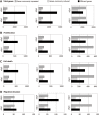Transcription factors specificity protein and nuclear receptor 4A1 in pancreatic cancer
- PMID: 34720529
- PMCID: PMC8517783
- DOI: 10.3748/wjg.v27.i38.6387
Transcription factors specificity protein and nuclear receptor 4A1 in pancreatic cancer
Abstract
Specificity protein (Sp) transcription factors (TFs) Sp1, Sp3 and Sp4, and the orphan nuclear receptor 4A1 (NR4A1) are highly expressed in pancreatic tumors and Sp1 is a negative prognostic factor for pancreatic cancer patient survival. Results of knockdown and overexpression of Sp1, Sp3 and Sp4 in pancreatic and other cancer lines show that these TFs are individually pro-oncogenic factors and loss of one Sp TF is not compensated by other members. NR4A1 is also a pro-oncogenic factor and both NR4A1 and Sp TFs exhibit similar functions in pancreatic cancer cells and regulate cell growth, survival, migration and invasion. There is also evidence that Sp TFs and NR4A1 regulate some of the same genes including survivin, epidermal growth factor receptor, PAX3-FOXO1, α5- and α6-integrins, β1-, β3- and β4-integrins; this is due to NR4A1 acting as a cofactor and mediating NR4A1/Sp1/4-regulated gene expression through GC-rich gene promoter sites. Several studies show that drugs targeting Sp downregulation or NR4A1 antagonists are highly effective inhibitors of Sp/NR4A1-regulated pathways and genes in pancreatic and other cancer cells, and the triterpenoid celastrol is a novel dual-acting agent that targets both Sp TFs and NR4A1.
Keywords: Ligand inhibitors; Nuclear receptor 4A antagonists; Nuclear receptor 4A1; Pancreatic cancer; Specificity protein; Transcription factors.
©The Author(s) 2021. Published by Baishideng Publishing Group Inc. All rights reserved.
Conflict of interest statement
Conflict-of-interest statement: Authors declare no conflict of interests for this article.
Figures





Similar articles
-
Specificity Proteins (Sp) and Cancer.Int J Mol Sci. 2023 Mar 8;24(6):5164. doi: 10.3390/ijms24065164. Int J Mol Sci. 2023. PMID: 36982239 Free PMC article. Review.
-
Specificity protein (Sp) transcription factors Sp1, Sp3 and Sp4 are non-oncogene addiction genes in cancer cells.Oncotarget. 2016 Apr 19;7(16):22245-56. doi: 10.18632/oncotarget.7925. Oncotarget. 2016. PMID: 26967243 Free PMC article.
-
Mechanism of metformin-dependent inhibition of mammalian target of rapamycin (mTOR) and Ras activity in pancreatic cancer: role of specificity protein (Sp) transcription factors.J Biol Chem. 2014 Oct 3;289(40):27692-701. doi: 10.1074/jbc.M114.592576. Epub 2014 Aug 20. J Biol Chem. 2014. PMID: 25143389 Free PMC article.
-
The nuclear orphan receptor NR4A1 regulates β1-integrin expression in pancreatic and colon cancer cells and can be targeted by NR4A1 antagonists.Mol Carcinog. 2017 Sep;56(9):2066-2075. doi: 10.1002/mc.22662. Epub 2017 May 9. Mol Carcinog. 2017. PMID: 28418095 Free PMC article.
-
Specificity Protein Transcription Factors and Cancer: Opportunities for Drug Development.Cancer Prev Res (Phila). 2018 Jul;11(7):371-382. doi: 10.1158/1940-6207.CAPR-17-0407. Epub 2018 Mar 15. Cancer Prev Res (Phila). 2018. PMID: 29545399 Review.
Cited by
-
RFC2 promotes aerobic glycolysis and progression of colorectal cancer.BMC Gastroenterol. 2023 Oct 11;23(1):353. doi: 10.1186/s12876-023-02984-0. BMC Gastroenterol. 2023. PMID: 37821801 Free PMC article.
-
Comprehensive analyses of the microRNA-messenger RNA-transcription factor regulatory network in mouse and human renal fibrosis.Front Genet. 2022 Nov 15;13:925097. doi: 10.3389/fgene.2022.925097. eCollection 2022. Front Genet. 2022. PMID: 36457754 Free PMC article.
-
Differentiation of BCMA-specific induced pluripotent stem cells into rejuvenated CD8αβ+ T cells targeting multiple myeloma.Blood. 2024 Mar 7;143(10):895-911. doi: 10.1182/blood.2023020528. Blood. 2024. PMID: 37890146 Free PMC article.
-
Thioredoxin Domain Containing 5 (TXNDC5): Friend or Foe?Curr Issues Mol Biol. 2024 Apr 4;46(4):3134-3163. doi: 10.3390/cimb46040197. Curr Issues Mol Biol. 2024. PMID: 38666927 Free PMC article. Review.
-
Transcription factor FOXF2 promotes the development and progression of pancreatic cancer by targeting MSI2.Oncol Rep. 2024 Jul;52(1):93. doi: 10.3892/or.2024.8752. Epub 2024 Jun 7. Oncol Rep. 2024. PMID: 38847273 Free PMC article.
References
-
- Siegel RL, Miller KD, Jemal A. Cancer statistics, 2020. CA Cancer J Clin. 2020;70:7–30. - PubMed
Publication types
MeSH terms
Substances
LinkOut - more resources
Full Text Sources
Medical
Research Materials
Miscellaneous

